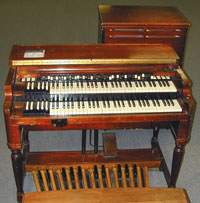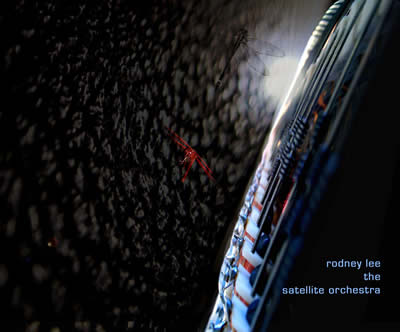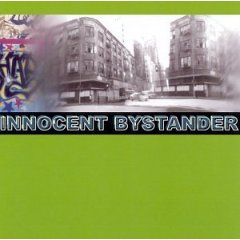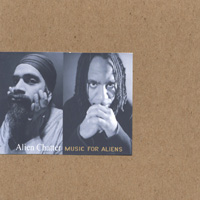|
The
Hammond B3 |

Weapon of Choice: Hammond B3
The
Hammond B3 organ is a tone wheel organ made by the
Hammond Organ Company. It is considered the most popular Hammond organ
of all time, and has been used in a great number of popular rock bands
and jazz ensembles.
The Tonewheel System
In imitation of a pipe organ, with its banks of pipes in multiple
registers, the Hammond Organ used additive synthesis
of waveforms from harmonic series to generate its sounds. As in Thaddeus
Cahill's earlier Telharmonium, the individual waveforms were made
by mechanical "tonewheels" which rotated beneath electromagnetic
pickups. Although they are generally included in the category of electronic
organs, strictly speaking, because the waveforms are produced by mechanical
tonewheels rather than electronic oscillators, original Hammond organs
are electric rather than electronic organs.
The component waveforms can be mixed in varying ratios by using "drawbars"
mounted above the two keyboards. The drawbars, which operate like
the faders on an audio mixing board, allow the performer to vary the
volume of each notes' fundamental tone, the octave below it, and the
octaves and harmonics above it. Other features added to Hammond organs
included an electromechanical vibrato and, by the late 1950s, a reverb
effect which simulated the reverberation of a large church hall.
Follow this link to see the tonewheel in action:
keyboardmuseum
-- click the key with your mouse
Hammond organs have a distinctive percussive "key click",
which is the attack transient that occurs when all nine key contacts
close and cause an audible pop or click. Originally, key click was
considered to be a design defect and Hammond worked to eliminate or
at least reduce it by using equalization filters. However, some performers
liked the percussive effect, and it has become part of the "Hammond
sound", which modern imitators of the Hammond organ try to reproduce.
Speakers originally designed by Don Leslie were widely used with the
Hammond organs, though at first, Leslie was a competing company that
Hammond sought to drive out of business. The Leslie speakers
had a rotating horn and a stationary bass speaker with a rotating
baffle that produced a vibrato effect. As well, the Leslie speaker
cabinets' tube (also known as "valve") amplifier gave the
Hammond's tone a warm, natural "overdriven" sound, which
could be varied from a mild "purr" to a heavily overdriven
growl. Soon, the Leslie speaker cabinet's signature sound became a
de facto requirement for Hammond enthusiasts.
Follow this link to see a Leslie Speaker in
action: keyboardmuseum
-- click the buttons to listen
The lightweight construction of the "waterfall"-style keyboard
for the upper manuals allows for very rapid passages to be executed
with more ease than on a weighted keyboard, such as a piano or pipe
organ. This has allowed such masters of the instrument as Joey
DeFrancesco and the late Jimmy Smith to
fire off lightning-fast flurries of notes during their solos.
Types of Hammond organs
The model B-3 was, and still is, the most sought-after
model, though the C-3 differs only in cosmetics. Hammonds can be divided
into two main groups: the 'Console' models such as the B-3, C-3 or
A-100 which have two 61 note manuals and the smaller 'Spinet' models
that have two 44 note manuals such as the M-3, L-100 and the M-100.
Hammonds' serial numbers are not sequential from one production lot
to the next, which can make it difficult to determine the date of
manufacture of a Hammond organ.
Playing the Hammond organ
Pianists and synthesizer players who begin playing the Hammond soon
realize that authentic performance practice involves a lot more than
playing the notes on the keyboard. Hammond players vary the timbre
of both manuals in real time through a combination of changing drawbar
settings, engaging or disengaging the vibrato/chorus effects or percussion
settings, and changing the rotating Leslie speakers' speed setting.
As well, performers obtain other effects by increasing the Leslie
speakers' volume to add natural overdrive or "growl" for
certain passages, or by switching the Leslie speaker's run motor off
for a brief moment, which produces a wobbly pitch-bend effect.
There are playing styles that are specific to the Hammond organ, such
as palm glisses, rapid repetition of a single note, tremolo between
two notes a third apart (typically the 5th and flat 7th scale degree
of the current chord), percussive drumming of the keyboard, and playing
a chord on the upper manual, then sliding your hand down to duplicate
the chord on the lower manual. Artistic use of the foot-controlled
expression pedal -- which controlled the Hammond's volume level --
and bass pedals are also important facets of the art of the Hammond.
Pianists making the transition to Hammond organ have to learn to use
their feet to perform bass lines on the bass pedal board. Although
the pedal board can be used in a very simple fashion (for sustained
or slow-moving bass notes), professional-level Hammond players typically
develop the ability to perform fast-moving bass lines on the bass
pedal board.
"Clones" and emulation devices
Due to the difficulties of transporting the heavy Hammond organ, bass
pedal board (a B-3 organ, bench and pedal board weighs 425 pounds/193kg)
and Leslie speaker cabinets to performance venues, and due to the
risk of technical problems that are associated with any vintage electromechanical
instrument, there was a strong demand amongst musicians for way of
recreating the Hammond sound in a more portable, reliable fashion.
Some early emulation devices were criticized for their unrealistic
imitation of the Hammond sound, particularly in the way the upper
harmonics were voiced, and in the simulation of the rotary speaker
effect. Refinements to Hammond emulations eventually led to the development
of relatively light electronic keyboard instruments such as the Roland
VK-7 and the KORG BX-3 and CX-3
that produce a fairly realistic re-creation of the Hammond tone.
By the 1990s and 2000s digital signal processing and sampling technologies
allowed for better imitation of the original Hammond sound, and a
variety of electronic organs, emulator devices, and synthesizers provided
an accurate reproduction of the Hammond tone. Hammond Suzuki
USA currently markets numerous home, church, and professional
models that digitally reproduce the sound of vintage Hammond tonewheel
organs.
Some sophisticated emulation devices have algorithms that recreate
some of the characteristics of the vintage Hammonds, such as the "crosstalk"
or "leakage" between the tonewheels, and digital simulations
of the rotating Leslie speaker cabinet's sound. Nonetheless, an article
entitled Clonewheel Heaven in Keyboard Magazine that reviewed electronic
simulations of the traditional Hammond sound claimed that some aspects
of the vintage electromechanical Hammonds' sound are not accurately
reproduced by clones and emulation devices.
Current interest in Hammond organs
Despite the availability of relatively lower-cost, reliable digital
"clones" and emulation devices, there is still a strong
interest in vintage Hammond organs. Even the difficulties of finding
spare parts and trained repair personnel for such a complex instrument
has not dissuaded musicians from continuing to use vintage Hammonds.
Original electromechanical Hammond organs are prized by musicians
from jazz, blues, rock, gospel, and other musical styles for the look
and feel of their varnished wooden cabinets and "waterfall"-style
keyboards, and their vintage, traditional sound. Although the last
electromechanical Hammond organ came off the assembly line in the
mid-1970s, it is a testament to their over-engineered design and high-caliber
construction that thousands are still in daily use.
-- courtesy of wikipedia
|
The
Hammond B3 in Action
| Track |
Listen
Further/Buy |
| The
first track is a sample from the incredible Jimmy Smith. The
tune is "Back at The Chicken Shack". |
|
| Richard
Tee playing "Uptown and Country" from Tom Scott's
New York Connection album |
|
| Art
Neville of The Meters playing Look-Ka Py Py |
|
| Yes
"Roundabout" |
|
D'Angelo
on "Higher" from his Brown Sugar CD
Check out live footage of D'Angelo playing rhodes here |
|
John
Medeski of Medeski, Martin, and Wood playing "Night Marchers"
Check out live footage of MMW here. |
|
Innocent Bystander -- Mechanized Madness, and Capt. Lee's
Scotch
I
studied jazz organ as a kid, but I have never owned a B3.
(It's at the top of my wish list). I learned to play organ
on a Yamaha home organ, and played on B3's in Baptist churches
for years. Lately, I have been experimenting with placing
the hammond sound in electronica tracks and my CD Innocent
Bystander is all about that. Using the Hammond sound
as the foundation, I experimented with running it through
various effects to create unique pads and lead tones. Most
of the hammond sounds on this CD came from a Voce
B3 module. I don't have it anymore because it got
fried at the Istanbul Jazz Festival when a tech plugged it
into the wrong power. My weapon of choice now is the B4
vst software made by Native Instruments.
|
|
|
Hammond
B3 Emulations
Because
Hammond B3's are
so heavy, there are a number of emulations on the market in both keyboard
and software forms.
| Product Name |
Manufacture |
Comments |
| B4
II -- software |
Native
Instruments |
This software version of the Hammond B3 sounds amazing to
me. Until I can make room for the real thing in my studio this
is my weapon of choice. |
| EVB3
-- software |
Logic
Audio |
I use this version occasionally as well. It's not as good
as the B4, but it is very useful. |
VK-8
-- keyboard
VK8M
-- module |
Roland |
I've rented quite a few of these on the road and they sound
great, especially if you can run it through an actual Leslie
speaker. |
| XK3
-- keyboard |
Hammond |
I have used these as well and it sounds really cool too. It's
probably my favorite among the keyboard versions. |
|
Links
to Hammond B3 Parts, Maintenance and more
Here
are a few links to some great Hammond B3 Sites
| google "Hammond B3" |
I know this is a cop out, but there are so many
Hammond B3 sites that it is impossible for me to refer you to
just one. Just google and you'll see. |
| speakeasyvintagemusic.com |
But here is a good one for parts and service |
| vintagevibe.com |
Hammond B3 parts and service |
| |
|
|
|
| Current
Releases |

Rodney Lee -- The Satellite Orchestra

Innocent Bystander

Alien Chatter
featuring
Satnam Ramgotra &
Rodney Lee |

Need
Sheet Music Fast?
Download
Digital Sheet Music
from the number one source on the web
  |
|
